In the tumultuous annals of the Horus Heresy, a dark and foreboding chapter emerges – the Ruinstorm. This malevolent cosmic phenomenon, born from the sorcerous machinations of the traitorous Warmaster Horus, cast its suffocating shadow across the galaxy, severing communication and sowing chaos among the Imperium’s scattered realms.
As the Ruinstorm raged, it became a breeding ground for nightmarish entities, twisted reflections of the Warp’s darkest corners. These abominations, known as the Daemons of the Ruinstorm, are a haunting testament to the perils of dabbling with the forbidden arts of the Warp.
From the eerie echoes of their howls resonating through the void to the havoc they wrought upon unsuspecting worlds, the Daemons of the Ruinstorm became harbingers of despair and instruments of the traitors’ grand design. Join us on a journey into the heart of the Ruinstorm, where the veil between reality and the Warp frayed, allowing these nightmarish entities to claw their way into the material realm, forever leaving an indelible mark on the galaxy’s darkest hour.
We covered the Ruinstorm Daemons army list in Episode 12 in Year 7, which you can listen to here:-
The Deamons of the Ruinstorm army list was released as a Legacies of the Age of Darkness PDF, which can be downloaded here.
Army Special Rules
Ætherial Invulnerability
It’s a save that provides immunity. You know it’s important, but unfortunately, it doesn’t offer protection against force weapons.

Immaterial Blades
In essence, it’s a weakened variation of Rending. Any attack that scores a wound roll of 6 increases the Armor Penetration (AP) value to the value within brackets, surpassing its original value.
Daemon Unit Type
Daemons possess Fear (1) and are also immune to Fear, while they automatically pass any Pinning checks, which is now a significant concern. However, it’s essential to note that daemons cannot intentionally fail morale checks, and any failures result in d3 wounds rather than retreating.
The more significant issue revolves around Degradation. In turns 1 and 2, your forces benefit from a +1 boost to their strength and toughness. In turns 3 and 4, these bonuses vanish, and in turns 5 and 6, your forces experience a -1 penalty to their strength and toughness, with turn 7 amplifying these penalties to -2. Prolonging the game can pose a genuine risk for you.
Ætheric Dominions
Information about the Warp and Chaos, in general, was restricted from the public, leaving most people in the dark about their workings. Instead of perceiving a singular deity, people believed that these entities were influenced by certain malevolent intelligences.
Each unit in the army is required to select a Dominion, and your detachment may exclusively consist of units sharing the same Dominion.
Encroaching Ruin
Daemons are equipped with the Move Through Cover ability. Units possessing solely this rule will incur only 1 wound as a consequence of failing a morale check.
Heedless Slaughter
Daemons are compelled to charge any units situated within an 8″ radius.
Additionally, units exclusively possessing this rule gain a +1 bonus to their charge moves, combat resolution, and sweeping advance checks.
Formless Distortion
In the Fight subphase, your daemons roll a d3, which provides a random enhancement to their melee attacks
- Lance and Concussive (1)
- Reach (1)
- Shred and Sunder
Putrid Corruption
Daemons get the Heavy Subtype, along with a unique 5+ damage mitigation roll that can be utilized against any damage, except for Instant Death or psychic damage.
But the Heavy Subtype significantly limits the unit’s mobility, prohibiting them from running and reducing their movement-based reactions by -1″. This can be particularly challenging for a unit composed solely of melee footsloggers.
While rerolling saves against templates might primarily be effective against less powerful Flamers and Frag missiles, as most other templates possess AP to surpass your 4+ save, the 5+ damage mitigation will come into play more frequently than anticipated.

Ravenous Dissolution
Daemons receive a +1 bonus to hit Psykers, Independent Characters, other Daemons, and Corrupted units during the initial turn of combat.
Essentially functions as an enhanced version of Hatred.
Rapturous Sensation
Successful charges that aren’t disordered also grant the unit the ability to fight at a higher Initiative for the turn, potentially outpacing Praetors. Units exclusively governed by this rule have the advantage of re-rolling failed tests for Blind and Concussive weapons.
Emperor’s Children players can vouch for the advantages of striking with higher Initiative.
However, this dominion offers more bonuses on top of that, making it appear like an excellent choice on paper. But, in practice, it’s worth questioning whether you truly need the ability to strike faster when your units already possess a high Initiative, formidable AP, and the inherent benefit of Murderous Strike. After all, you’re already positioned ahead of adversaries with Power Fists and Thunder Hammers in the initiative order.
Malevolent Artifice
Daemons possess the ability to re-roll any armor saves when facing attacks where the attacker’s strength is lower than their toughness.
This attribute makes the model exceptionally resilient against standard-issue units and equipment. Any attack with lower strength is likely to wound on a 5+ or worse, so the re-roll comes in handy in mitigating the damage from those rare successful hits.
Low-strength attacks typically feature poor AP values but are frequently delivered in large quantities, such as boltguns or chainswords, making this save valuable over time.
Infernal Tempest
Daemons come equipped with Hammer of Wrath (1) or a +1 bonus to any existing Hammer of Wrath (X) value and an added bonus that any Hammer of Wrath hits gain the Deflagrate property, adding an extra element.
Furthermore, they gain access to a unique weapon: an 8″ ranged attack with Strength equal to User, AP5, and Assault 2, also featuring Deflagrate. This weapon can only be employed as a reaction but guarantees that it always hits. While the auto-hitting aspect is advantageous, the AP5 might make it easy for Marines and similar units to resist its effects
Many of your units inherently possess Hammer of Wrath, providing additional automatic hits, usually at Strength 5, with the potential for more automatic hits via Deflagrate. This is a noteworthy advantage, particularly when deterring opponents from launching reckless charges and enabling your units to remain effective in close combat.
It makes Return Fire is a viable reaction. While the short range makes it less likely to be triggered, anyone who shoots you from this distance is likely to charge you in the subsequent phase. This means you might have two rounds of shooting by using two reactions if the situation aligns.
Wargear
Melee Weapons
Daemon Armaments
The standard weapon for your basic squads consists of S User, AP4 and the added benefit of Immaterial Blades (AP3). This combination presents a credible threat to MEQs in substantial numbers.
Infernal Armaments
The next tier of melee weapons, accessible to Hierarchs, Brutes, and Greater Daemon Beasts, features AP3 and the added benefit of Immaterial Blades (AP2). This makes them the preferred choice for dispatching high-value targets that require substantial killing power. To top it off, these weapons are equipped with Brutal (2), enhancing the lethality of these units by turning their attacks into a potential death blender when used en masse.
Harbinger Blade
Exclusively accessible to Daemon Harbingers, as indicated by their name. These weapons essentially combine the concept of Infernal Armaments but replace the Brutal (2) feature with Murderous Strike (6+).
In a force predominantly composed of formidable creatures, only a few units have the capability of inflicting Instant Death. This is the first instance where you gain the ability to eliminate Space Marine Characters in a single blow after the initial two turns, which is a noteworthy advantage, particularly against resilient adversaries.
Behemoth Blade
This particular upgrade is available to Behemoths and comes as a default feature on Arch-Daemons.
The weapon has a Strength equal to the user with AP2, accompanied by Brutal (3) and Sunder, rendering it highly lethal.
Additionally, it’s equipped with Immaterial Blades (AP1) which mostly holds theoretical significance, except when confronting vehicles. However, depending on the wielder and the turn number, there’s the potential for adversaries to face over fifteen saves against Strength 8, AP2 (or AP1), which is an extremely daunting prospect, and very few characters can withstand such a barrage.
Sovereign Armaments
This particular weapon, available Daemon Sovereign, combines the attributes of all the preceding weapons into one potent package. It boasts a Strength equal to the user, AP2, Brutal (2), Murderous Strike (5+), and Immaterial Blades (AP1). This combination makes it an exceptionally effective tool for eliminating characters and squads.
When you trigger Murderous Strike against a unit with an Atomantic Deflector or similar defenses, Brutal wounds are multiplied before saves. In this scenario, even a single successful wound results in two saves, and if they remain unsaved, they are further multiplied to D3 each. This makes the weapon particularly devastating against such resilient targets.
Sovereign Greatblade
This weapon can be considered the ultimate “devastator” outside of unique, one-of-a-kind weaponry. With Strength +3 and an AP1, coupled with Brutal (3) and Murderous Strike (5+), it becomes a fearsome instrument of destruction.
In the hands of a creature possessing a Weapon Skill of 6 or higher and five or more attacks, this weapon has the potential to utterly obliterate most targets, barring Primarchs and similarly formidable adversaries. However,it’s Unwieldy, meaning it necessitates a sacrifice in terms of the user’s high Initiative score when wielded.
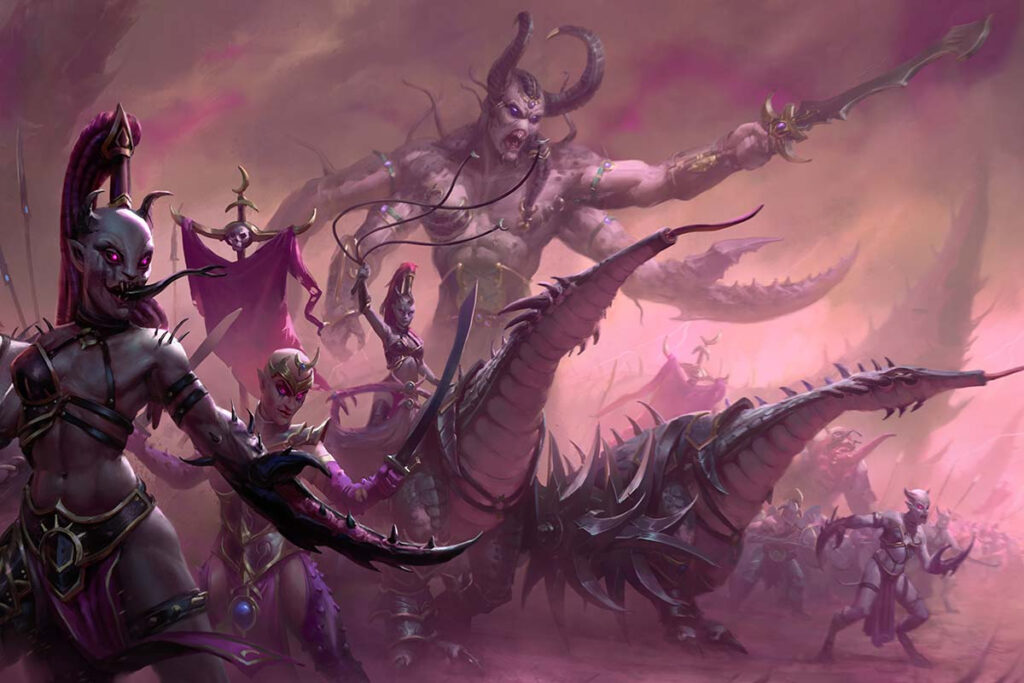
Ranged Weapons
Immaterial Projectiles
This standard weapon is offered as a replacement for units equipped with Daemon Armaments. It essentially provides a fundamental Assault 2, S User, and AP4.
In many instances, this basic configuration serves as the primary armament for your units. Notably, it’s the sole weapon at your disposal for Reaction purposes.
Immaterial Flame
This weapon is exclusive to Daemon Beasts and essentially functions as a Heavy Flamer. It is consistently equipped on a base Strength 5 unit, although the S:User characteristic may become less effective as the game progresses.
Despite its name, it is not specifically categorized as a “Flame” type weapon, which means it would bypass the unique defenses of certain units, such as the Salamanders and the Dreadwing.
Dark Flame
This is a consistent Strength of 5 and an AP5, regardless of the base unit’s strength. Additionally, it comes with Torrent (5″) and Fleshbane, making it an excellent choice for generating a multitude of attacks that automatically hit on a 2+ to-wound and can be particularly effective in forcing opponents to make numerous saves.
The Unmaking
Provides a fixed Strength of 8 and an AP1, combined with the Armorbane property. In essence, it functions as a Meltagun, making it an ideal choice for dealing with armored vehicles and instantly eliminating Toughness 4 models.
Upgrades
Ætheric Conduit
Daemons are transformed into a psyker, obtaining the ability to utilize one of the following disciplines: Biomancy, Diabolism, Pyromancy, or Telepathy.
Ætheric Flight
The cost-effective jump pack maintains the Bulky (2) trait or supplements an existing rule with a +1. However, it exclusively provides a permanent +3″ movement boost for aerial mobility. Furthermore, it categorizes all difficult terrain as hazardous terrain
Immaterial Wings
The genuine jump pack comes with the option of Bulky (2) or an additional +1 to an existing rule. It offers the capability to activate a 14″ move, and it even includes the Hammer of Wrath (+1) ability.
Miasma of Rage
When a squad contains a unit with this rule, that unit acquires Rage (2), but it doesn’t stack with any pre-existing iterations of the rule.
Warp-Forged Flesh
+1 to the unit’s save to a max of 2+
Warlord Traits
Conqueror of Kings
The Warlord gains +1 Attack when engaged in combat with an independent character, and both the Warlord and the unit it is part of receive a +1 Strength bonus when facing a unit that includes an independent character. Additionally, the Warlord can perform an extra reaction during the movement phase as long as the Warlord remains alive.
Entropic Force
Damage mitigation rolls for wounds inflicted by the Warlord will only succeed on a roll of 6. Furthermore, the Warlord can make an additional reaction during the movement phase as long as the Warlord remains alive.
Eternal Reveler
The Warlord and the unit they have joined have the ability to declare charges even after running, and when they do charge, they can opt to use the Warlord’s Initiative to determine the charge distance, skipping the usual dice roll. Additionally, the Warlord retains the capacity to make an extra reaction during the movement phase as long as the Warlord remains alive.
Walker of Paths
Following deployment, you have the option to remove two units from the tabletop and place them into reserves. Simultaneously, you can replace these units with two other units that are already located in reserves. Furthermore, the Warlord can take an additional reaction during the shooting phase as long as they remain alive.
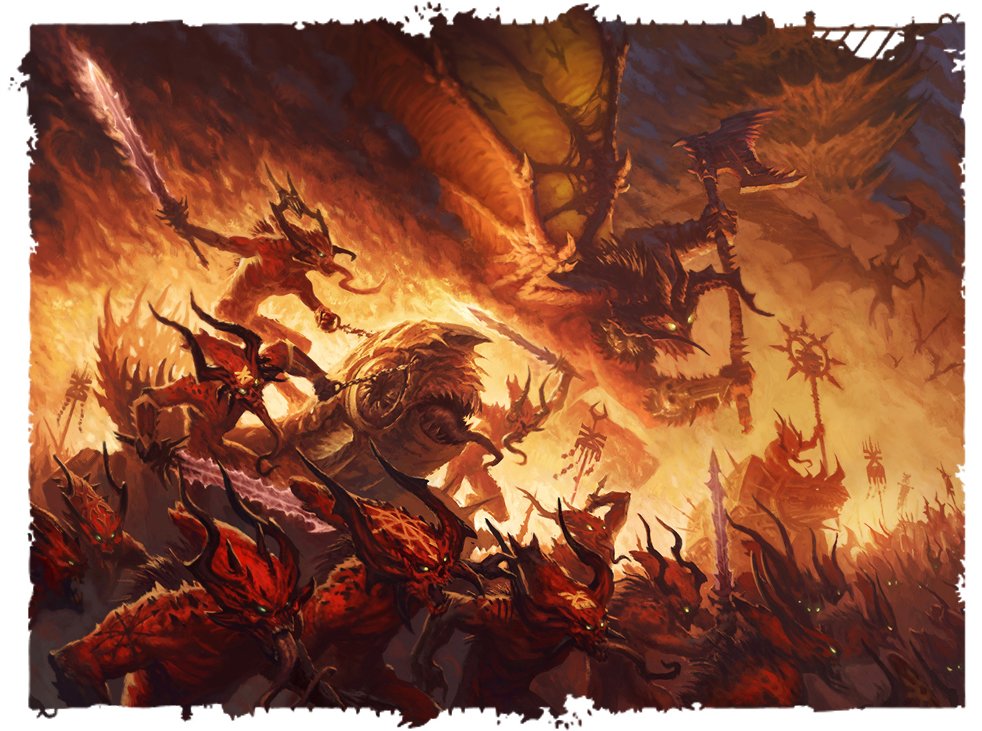
Units
HQs
Daemon Sovereign
When examining their stat-line and inherent potential, a Sovereign can be viewed as a somewhat scaled-down version of a Primarch. Their higher cost is justified by their impressive stats: with a Weapon Skill of 6, Strength 7, and deliver five attacks, each carrying some variation of the powerful Brutal and Murderous Strike abilities, making them a formidable threat to most adversaries.
While they are not entirely immune to Instant Death, their Empyrean Avatar grants them resistance similar to Dreadnoughts, and their Toughness 6, seven wounds, and a 3+ armor save combined with a 4++ invulnerable save and the It Will Not Die rule (5+) make them challenging to eliminate, particularly for opponents lacking Instant Death capabilities.
All of these attributes are considered prior to factoring in upgrades, such as enhanced weaponry, flight capabilities, ranged attacks, Rage(2), or the addition of psychic powers.
Through disciplines like Biomancy or Diabolism, they have the potential to further enhance their own strength and resilience, making them even more lethal or providing valuable support to nearby units.
In direct combat against nearly any non-unique character in the game, they are likely to come out victorious!
Daemon Hieracrch
Selling The Hierarch is a tough task. It is 115 points higher than the Harbinger, and the primary distinction lies in just a slight boost of +1 to its Ballistic Skill, Wounds, and Attacks.
Although it boasts a broader array of customization choices compared to the Harbinger, it falls short of being an Independent Character or a Monstrous Creature like the Sovereign. This means The Hierarch will likely be operating solo, and in this edition, a solitary character is at a significant disadvantage, often leading to their demise.
Daemon Harbinger
For a lower cost than that of The Hierarch, you can acquire a unit that, while still not an independent character and offering fewer customization options, comes with the unique ability to lead a squad of Brutes, ready to take on any threats that dare to approach. If your strategy involves keeping him closely surrounded by his minions, it’s almost a no-brainer to include the Miasma of Rage.
His most appealing feature is the Herald of Unreality rule, which enables the placement of two non-Lord of War units in reserve, with an additional one for each other Herald present in the army. These reserved units can subsequently emerge from a warp rift originating at his position, effectively bypassing their normal shooting phase. These units arrive automatically without the need for dice rolls, and they are free to take actions and charge on the very turn they arrive. In essence, this turns the Harbinger into a formidable commander capable of summoning greater daemons with a mere gesture of his hand!
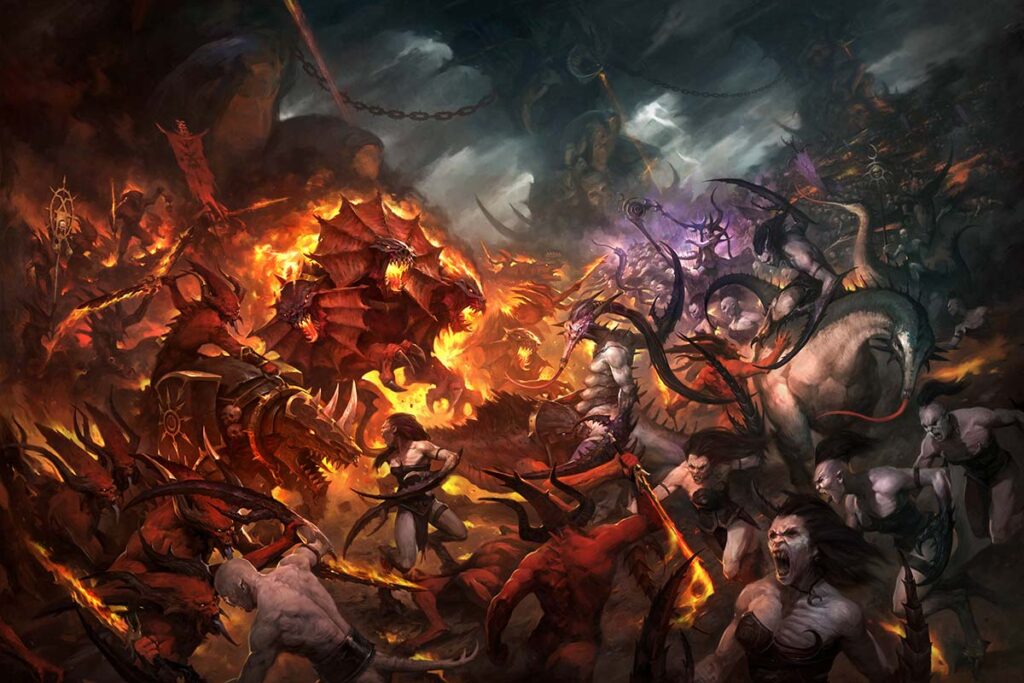
Davinite Lodge Priest
Yes, you can include one, as they are accessible to “an army with any faction as a non-compulsory HQ choice.”
Their distinctive skill, Ritual Healing, is only effective on Infantry units, and there isn’t a single unit of that category in the entire army list. Furthermore, it won’t even benefit the priest personally, as they are likely to be defeated before having a chance to utilize it.
Opting for a Davinite Priest would essentially mean investing 50 points in an S3 pistol with a range that outstrips nearly everything else in the army by 6 inches, and that’s essentially the extent of their contribution. Not worth it really!
Elites
Daemon Brutes
These formidable warriors are imposing adversaries, wielding powerful Strength 5 AP3 weapons enhanced by the brutal and armor-piercing qualities of Immaterial Blades (AP2).
Additionally, they pack a punch with their Hammer of Wrath (1) ability, and their Toughness 5, a 4+ armor save, 5++ invulnerable save, and three wounds per model make them exceptionally durable. They offer minimal flexibility, with the sole choice lying in the Ætheric Dominion that the army selects.
Their Bulky (3) status also makes them quite resilient, as overwhelming them with numbers won’t be as simple as it might initially seem. A squad of nine equipped with Brutal capabilities can unleash a significant volume of wounds with AP3 and AP2 attributes, making them a formidable force to contend with on the battlefield.
Daemon Beasts
Although they may not match the brutes in terms of durability or raw power, the beasts compensate with remarkable speed, boasting a movement speed of 10″. Moreover, you have the option to acquire Ætheric Flight, enabling them to traverse terrain with ease.
Their Daemonic Armaments, with Strength 5, give them a notable offensive capability. Furthermore, they possess a unique feature as the only unit capable of wielding the Daemonic Flame weapon, granting you the opportunity to deploy a pack of creatures that can unleash templates of destructive flames.
Troops
Lesser Daemons
Basic Daemons have seen a reduction in their effectiveness compared to the previous edition.
They are now single-wound models with a Ballistic Skill of 3, offered at a cost that remains relatively unchanged from before.
However, there is notably less room for customization. The primary choice lies in deciding whether to equip them with melee or ranged weapons, with limited options available outside of the Dominion selected for the detachment.
Daemon Swarms
These are Support Units so can only be included in your army after filling the Compulsory slots with regular lesser daemons.
While they do not deteriorate automatically as the game progresses like in the previous edition, they remain vulnerable and are easily eliminated by bolter fire starting from turn five when they reach Toughness 2.
As they are Line units, they can be instrumental in capturing objectives on the battlefield. However, they are less effective than in the previous edition, equipped with only 2 attacks per base and lacking any options for ranged weapons or other customizations. Additionally, their meager 6+ save means that their primary utility lies in being inexpensive “Line” units, with little potential to make significant contributions to the battle.
Two notable advantages set them apart from Lesser Daemons. First, their Skirmish subtype allows for a larger squad coherency and provides a +1 bonus to any cover saves they receive. This is crucial, as these units greatly benefit from seeking cover on the battlefield. The second advantage is their base movement speed of 8, which outpaces other infantry in the army and makes them more efficient in claiming objectives.
Fast Attack
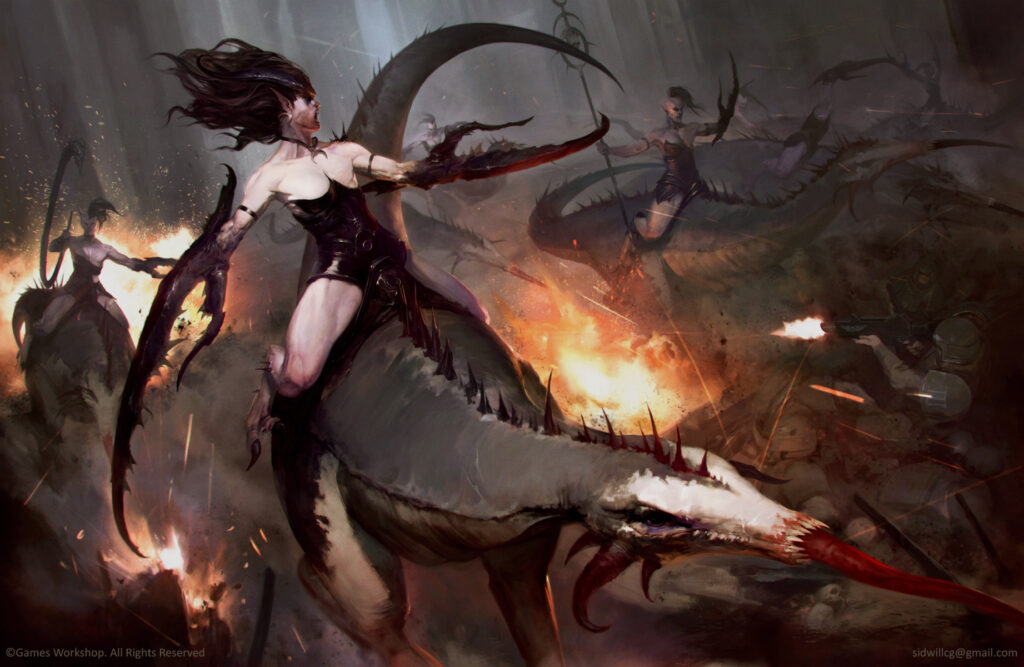
Daemon Cavalry
Daemon Cavalry, while possessing a move distance of 12″, lack the full benefits associated with the Cavalry subtype. They primarily feature a move speed advantage without additional special traits. Each of these Daemon Cavalry units has two wounds and two attacks per model, along with a baseline 4+ save, making them more effective in close combat than Lesser Daemons.
However, if you’re seeking fast-moving melee squads, Daemon Beasts in the Elite slot may be a more favorable choice overall.
In terms of points efficiency, Cavalry units fall short compared to Beasts. For both units, the cost per wound and attack averages at 10 points per model. However, the initial point investment for Cavalry is significantly higher at 50 points for a unit, as opposed to 20 points for Beasts. Beasts also enjoy the advantage of higher Strength.
Even if you upgrade Beasts with Flight, you can attain a speed of 13″ and access to nine Strength 5 attacks for 125 points, while Cavalry provides 12″ and 10 Strength 4 attacks for 150 points.
Daemon Harriers
These winged Lesser Daemons trade one attack for an increase in Ballistic Skill. If you’re seeking fast-moving melee units, options like Beasts or Cavalry might better suit your needs.
The squad size is fixed at ten models, making the choice of keeping the Daemon Armaments less appealing.
The likelihood of rolling for AP3 is lower here than in every other unit in the army list, so investing in the Immaterial Projectiles upgrade is a wise choice to benefit from the accuracy boost.
The Harriers are better suited for ranged harassment, as they lack the versatility to fulfill roles that other Daemons in your army couldn’t already perform.
Even if it’s not explicitly stated on their profiles, Harriers all have the Bulky (2) characteristic and the Hammer of Wrath (1) ability, which aids them in close combat situations.
Heavy Support
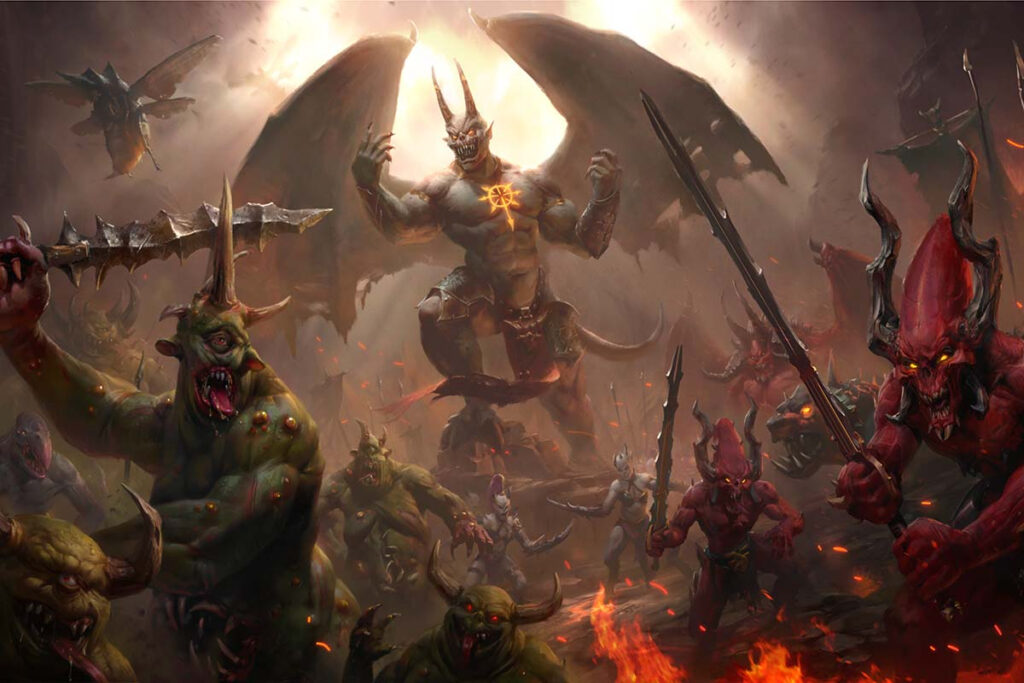
Greater Daemon Beasts
Essentially, you’re acquiring a more robust version of the Brute with the Monstrous subtype, although this subtype doesn’t carry significant benefits, as they lack ranged weapon options and cannot be pinned due to their Daemon classification.
While they do come with two extra wounds and one additional attack compared to Brutes, their lower Weapon Skill and Initiative make them less effective against elite opponents.
Despite the fact that a single Greater Beast costs more than three Brutes, their initial appeal may diminish once opponents realize that their base Strength and Toughness is only 5, making them less intimidating. This issue becomes even more pronounced as their stats decline, eventually reaching Astartes levels or worse.
It does seem that there may be a discrepancy in the design of this unit, as if the writers believed that the Monstrous subtype carried more significance than it actually does. For a more effective choice, bypassing this unit and considering Behemoths may be a better approach.
Daemon Behemoth
Now, here we have a more appealing option. These units essentially serve as the smaller counterpart to the Sovereign, coming at the same cost. They share a strikingly similar stat-line, though with slightly reduced Weapon Skill and Initiative.
Most of the same upgrades are available to them, with the exception of Psychic abilities and the Unmaking shooting attack that could have provided them with melta-equivalent shooting.
These units are undoubtedly valuable additions to your army, offering a means of including formidable powerhouses. Their Behemoth Blades are exceptionally intimidating and unique weapons, capable of annihilating both tanks and mortal adversaries with equal efficiency. This makes them a compelling choice to bolster your forces.
Lords of War
Arch-Daemon
The Arch-Daemon, with its superior stat-line, represents the closest non-unique character can get to a Primarch.
With the Gargantuan subtype, they gain resistance to various attacks that would otherwise pose a significant threat, such as those with Fleshbane or Poison. They are also notably immune to weapons with Psychic Focus, although Force Weapons, which ignore their Aetheric Invulnerability, remain a concern, as is the case with all other Daemons. Additionally, being Eternal Warriors means they are immune to Instant Death, which could be caused by Force Weapons or other weapons with this trait.
The Arch-Daemons come with the same upgrade options as Sovereigns, but their Gargantuan subtype excludes them from benefiting from psychic effects that could be applied to themselves, ruling out any buffing strategies in that regard. Nonetheless, they remain an immensely powerful and durable force on the battlefield, capable of rivaling even some of the most iconic characters in the game.
Named Characters
Ka’Bandha Unbound
Ka’Bandha, the Gargantuan Bloodthirster, stands as one of the most formidable and imposing entities on the battlefield. With stats that match those of a Primarch in many categories (except for BS5 and I6), he’s an absolute powerhouse.
His impressive attributes include A7, Leadership 9, immunity to stat modifications, Eternal Warrior, and the ability to force re-rolls on Poison and Fleshbane rolls. The Gargantuan subtype grants him the ability to move through terrain, effectively giving him unrestricted mobility. He can also use his wings to achieve jetpack-like 14″ movement, enabling him to engage or reposition rapidly. Notably, he can also unleash shooting attacks at any target from any position on the battlefield.
Ka’Bandha’s offensive capabilities are nothing short of terrifying. With seven attacks at Strength 12, augmented by Hammer of Wrath (d3) and Rampage (d3+1), he is a close combat juggernaut.
Despite counting as 10 models when outnumbered, Rampage can still be quite effective. Defensively, he boasts a 3+ armor save, a 4++ invulnerable save, It Will Not Die (5+), and Adamantium Will (3+), which, in his case, primarily guards against Force weapons due to the Gargantuan subtype rendering him immune to most other psychic powers.
His unique Warlord Trait, “Skull-Keeper,” augments any daemons from the Heedless Slaughter dominion within 12″, granting them Rage (3) for even more potent charges.
Ka’Bandha’s “Eternal Rivalry” with Sanguinius, stemming from their encounter on Signus, provides additional depth to his character. If both are fielded, a special secondary objective allows Ka’Bandha to challenge Sanguinius to a duel. Slaying Sanguinius earns 2 VP, while Ka’Bandha’s death results in a loss of 1 VP, in addition to the VP scored for Slay the Warlord.
Ka’Bandha has both melee and ranged profiles. In close combat, he wields a Two-Handed S+4 AP2 behemoth with Sunder, ideal for carving through armored targets. At range, he employs a close-quarters machinegun with a 6″ range, Strength 6, and AP2, delivering a devastating Assault 7 attack to mow down lesser foes.
The “Scythe of Hatred” adds an extra layer to his melee prowess. After all his melee attacks and accounting for Sweeping Advances, he can unleash a Hellstorm Flamer attack. The number of hits is equivalent to the unsaved wounds he caused in that round, allowing him to eliminate additional enemy units following a successful melee engagement.
Unbound Ka’Bandha, while functionally similar to Bound Ka’Bandha, differs mainly in benefiting or suffering from Daemonic stat changes during the battle and having the ability to be deployed without summoning. He also enjoys a slight advantage due to a change in the Heedless Slaughter Dominion, which allows him to add +1 to his Charge rolls, enhancing his already devastating charges.
Ka’Bandha is a true force to be reckoned with on the battlefield, offering both incredible combat prowess and strategic versatility.
Cor’bax Utterblight Unbound
Cor’bax Utterblight boasts impressive stats, including M7, WS7, S7, T8, 9 wounds, I5, A5, and Ld10.
He excels in three primary areas: devouring almost anything that stands in its way, absorbing an extraordinary amount of damage, and wreaking havoc on the battlefield. With a Noxious Maw that benefits from a boosted Strength and Murderous Strike (4+), this grotesque creature can inflict substantial damage on its foes, especially in the early turns of the game when it has the opportunity to charge in with Hammer of Wrath (D3+1).
Defensively, it is incredibly robust, featuring Adamantium Will (3+), It Will Not Die (4+), Putrid Corruption (with the option to re-roll rolls for itself, thanks to Lord of Decay), Empyrean Avatar, Ætherial Invulnerability (4+, equivalent to its armor save), and a base Toughness of 8, which can further increase to 10 with potential Biomancy buffs, making it immune to Strength 6 attacks and lower. This formidable resilience makes it a challenging adversary, particularly in the early stages of the game.
The warlord trait, “Lord of Decay,” provides a 3″ aura that enhances Putrid Corruption daemon units by allowing them to re-roll failed Damaged Mitigation (specifically Corrupted Resilience and Feel No Pain rolls). Although the radius is somewhat limited, it still proves useful.
Noisome Tide of Flesh adds an intriguing dimension to its capabilities. In the event that this durable creature is defeated, it triggers an auto-explosion, unleashing Strength 6 hits that prompt Pinning tests on any non-daemon units within the vicinity. This effect can serve as a deterrent to enemies attempting to approach or deal with it. Furthermore, Noisome Tide of Flesh assists in mitigating the slow 7″ movement by allowing the model to ignore Difficult Terrain penalties.
Overall, they serve as a formidable presence on the battlefield, both in terms of offense and defense. Its unexpected and grotesque nature makes it a valuable asset for those willing to harness its unusual power.
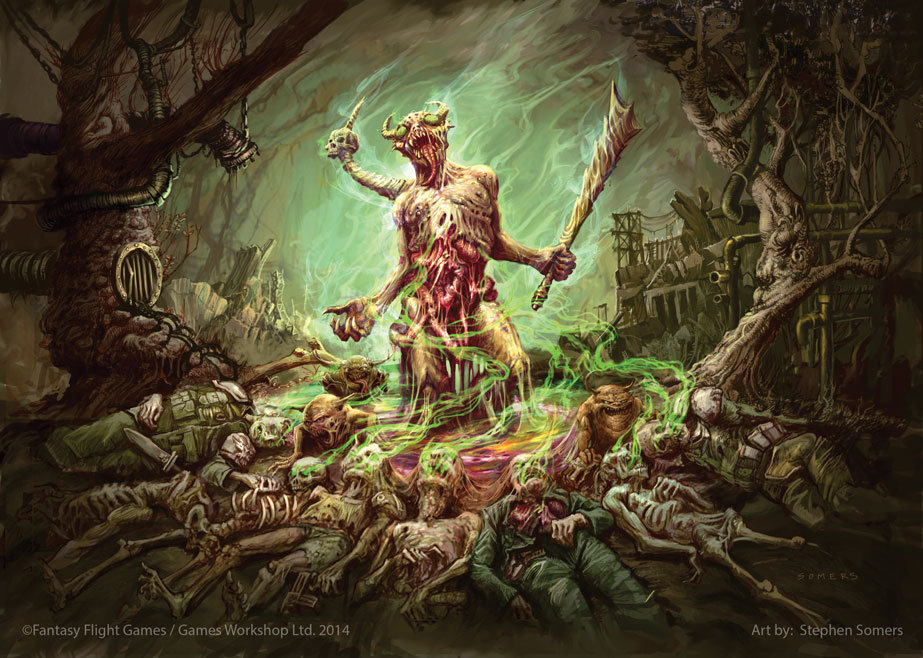
Samus Unbound
Samus is a formidable and versatile unit, a Monstrous entity with a 3+ armor save, a 4++ invulnerable save, and the ability to regenerate wounds with It Will Not Die (5+), he already possesses impressive durability.
The Empyrean Avatar rule, which reduces Instant Death attacks to dealing only d3 wounds, further bolsters his survivability. His mobility is noteworthy thanks to Fleet (2) and the Encroaching Ruin dominion, allowing him to traverse various terrains with ease.
Samus’s Warlord Trait, “The End and the Death,” is particularly potent, forcing re-rolls on successful invulnerable saves for all of his attacks, each of which carries AP2, Armorbane (Melee), and Murderous Strike (5+), significantly enhancing his combat prowess, making him a deadly close combat presence. His upgrade to Eternal Warrior adds another layer of resilience, rendering him immune to Instant Death.
“Whispers of Madness” introduces some interesting utility. Samus’s presence in reserves imposes a -1 penalty on all Reserve rolls for the enemy, potentially hindering their reinforcement strategies.
Once he’s summoned, he creates an 18″ aura, causing a -2 Leadership penalty for psychic checks. Furthermore, Samus can increase his Fear rating to Fear (2) through melee combat, adding another layer of psychological warfare to his capabilities.
Unbound Samus, functionally similar to Bound Samus, differs mainly in the context of benefiting or suffering from Daemonic stat changes throughout the battle and having the ability to be deployed without summoning. His flexibility and combination of offensive and defensive abilities make him a force to be reckoned with on the battlefield.


